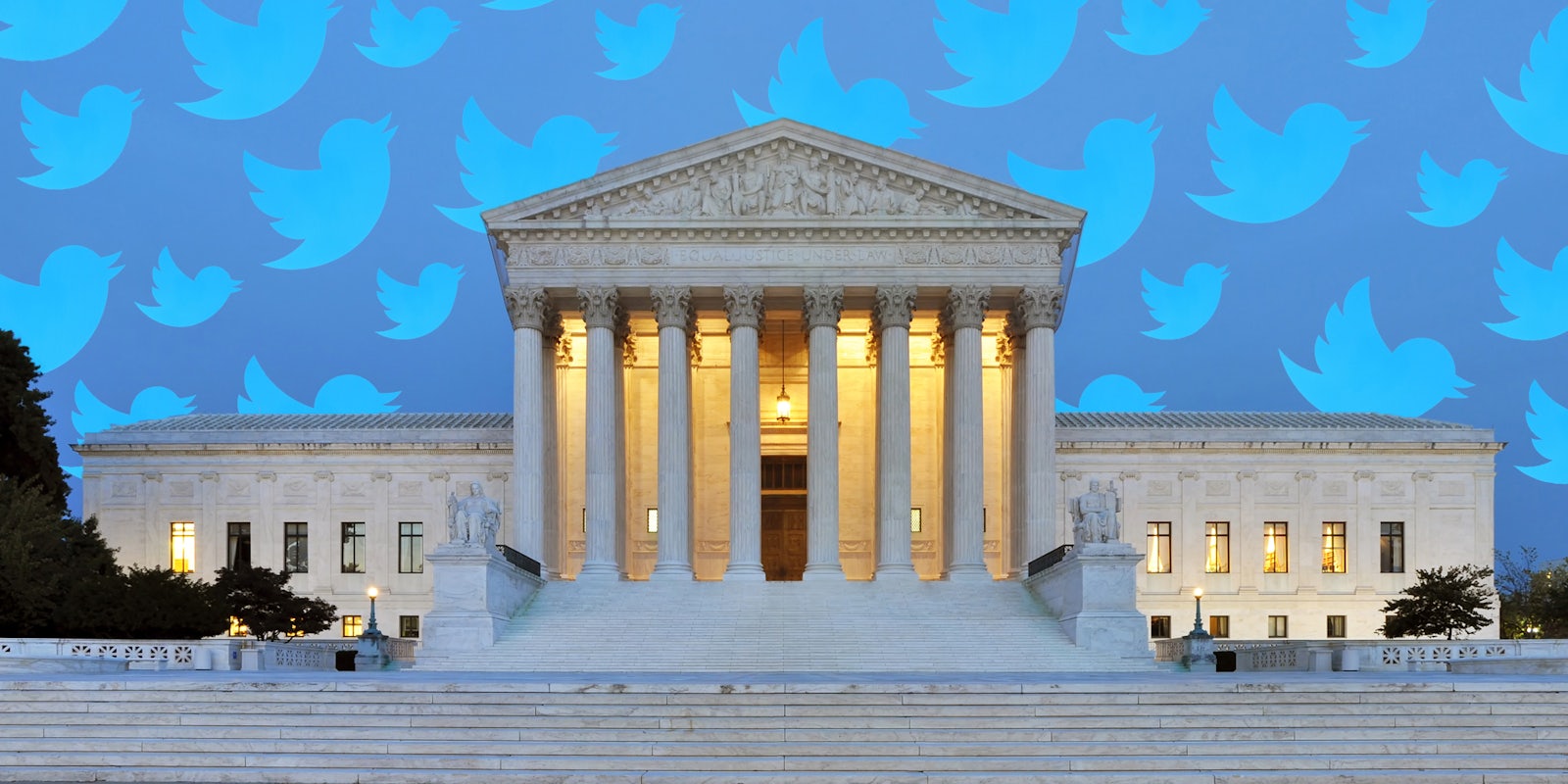The Supreme Court heard oral arguments today in Twitter v. Taamneh, a case that considers whether internet services are liable for terrorism-related content on their platforms.
The arguments dove into several rabbit holes over what, precisely “aiding and abetting” terrorist groups means for social media companies, including questions over ISIS’s exact use of Twitter.
The plaintiffs in Taamneh are arguing that Twitter, by harboring content from ISIS on its platform, was in violation of the Antiterrorism and Effective Death Penalty Act of 1996.
Twitter, on the other hand, argues that it had to know specifically what criminals on the platform were going to do in order to be liable for their actions.
Questioning began with Justice Clarence Thomas, who has shown interest in reigning in the protections for social media companies in the past, posing a hypothetical about providing a friend with a gun.
“I assume you would agree that if I had a friend who was a mugger, a murderer, and a burglar, other that was a good guy, and I loaned him a gun not knowing and not wanting to know what he was going to do with it, that that possibly could be aiding and abetting?” Thomas asked Twitter counsel Seth Waxman.
Waxman said it would not, under the legal definition set under Halberstram, which said there has to be a distinct awareness that someone is assisting in illegal activity. Waxman then countered with his own hypothetical about asking a neighbor to cut another neighbor’s padlock to steal a sheep from inside their fence.
“You know that you provided substantial assistance to me in entering the property, but you are not culpable within the meaning of the common understanding of the word aiding and abetting … because you are not generally aware of your role as part of an overall illegal or tortious act.”
Justice Sonia Sotomayor and Justice Elena Kegan then questioned Waxman about the difference between this case and other more tangible criminal cases.
“The distinction of all of the aiding and abetting cases draw between action and inaction is culpability,” Waxman explained. “And what is alleged to be culpable in this case is not the provision to billions of users of a communication platform subject to established policies which are enforced.”
Instead, Waxman said, the issue the plaintiffs are attempting to charge Twitter with is that Twitter knew through government reports and media reporting that terrorists were using Twitter to commit violent acts, but Waxman insisted that that does not meet the bar for aiding and abetting.
Justice Samuel Alito then stated that, if this were a criminal case, “it’s clear it would not be aiding and abetting liability” but said that the case does satisfy the first and second clauses of Halbestrom.
Essentially, Halbestrom’s standard for liability hinges on three parts. First, the party—in this case ISIS—aided by the defendant—in this case Twitter—must commit an illegal act that causes an injury. Second, the defendant must be generally aware of their role as part of an overall illegal or tortious activity at the time that they provide assistance. And third, the defendant must knowingly and substantially assist in the illegal act.
Twitter’s argument is that while ISIS did use Twitter to commit violent acts, they were not knowingly helping them and did not help them substantially.
Justice Sotomayor helped explain Twitter’s position.
“There is a focus on how much your platform helped ISIS and less on how you actually helped them, and there is a difference between the two things. … [Your argument is that] in a neutral business setting, using something that is otherwise not criminal, a platform, to communicate with people, and you’re doing it not … to help this particular person to commit a crime, but in a general business situation that others are coming to you and you can’t find them ahead of time, that that doesn’t constitute substantiality,” she said.
But Justice Kagan didn’t buy it. Kagan began to question just how safe Twitter could be with the wealth of knowledge it had that ISIS was in fact on its platform.
“If you know ISIS is using [Twitter], you know ISIS is going to be doing bad things … what work does turning your focus on the specific act do? Aiding ISIS is aiding the commission of specific acts in the future,” she said.
Justice Ketanji Brown Jackson brought up Twitter recommendations, something plaintiffs are saying helped recruit more ISIS fighters, a similar argument to the Gonzalez v. Google case the Court heard yesterday.
Eric Schnapper, who presented arguments for the plaintiffs in Gonzalez and presented arguments for the plaintiffs today as well, said that the recommendations did not lead to a direct and specific attack from the group, a standard Twitter said the plaintiffs would have to meet in the case.
While Twitter seems to have made the case that their culpability in this case lies in their assistance to a specific attack, which they deny providing, the Justices seem to be potentially also intimating that aiding a known terrorist organization in any way is indefensible.
“The material support statute [of the U.S. Code] says that if Osama Bin Laden walks in [to a bank] you can’t give him the money to buy a hospital,” Justice Kagan said. “It says there are some people, that even when you know it doesn’t have anything to do with their terrorist activities, you can’t support their non-terrorist activities.”
The Supreme Court is expected to rule on Gonzalez and Twitter this fall.



